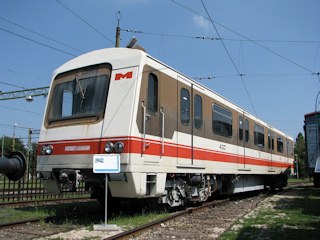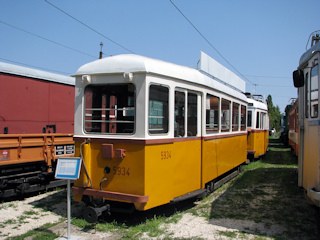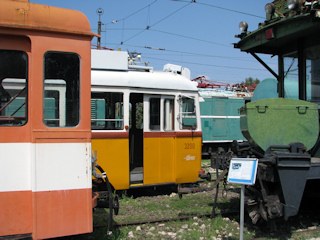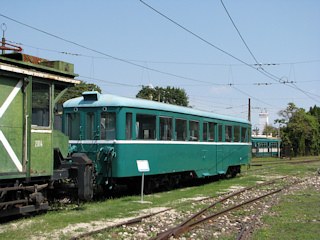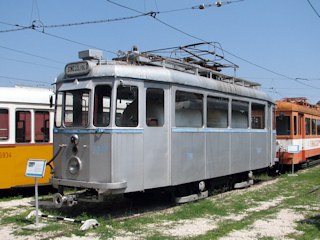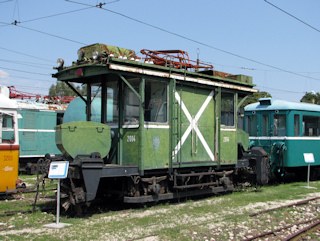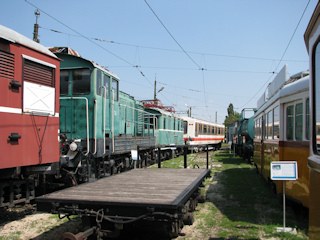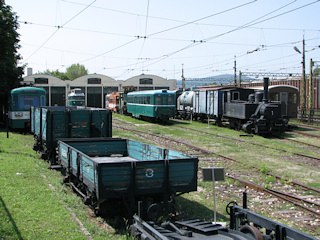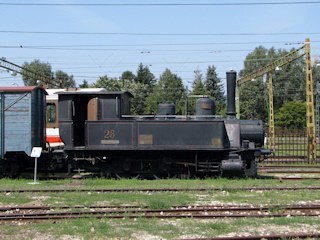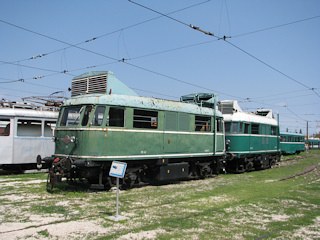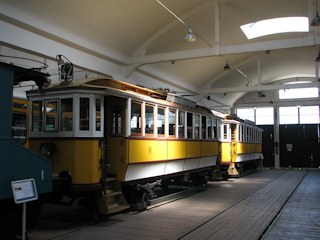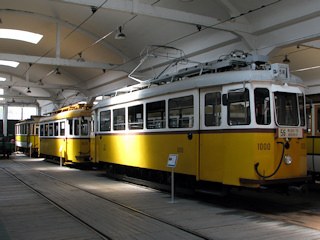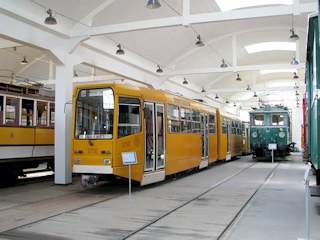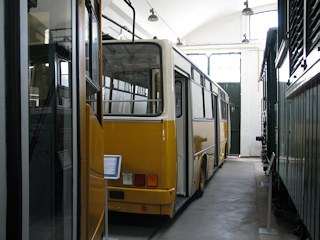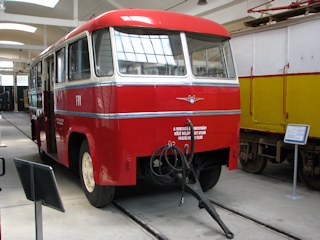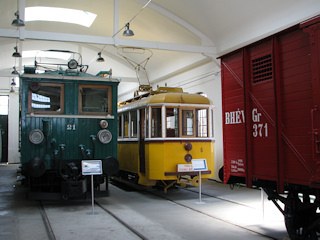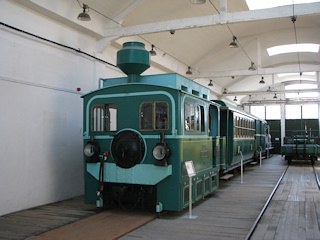budapest
other hungarian
close-up
lost rails
other countries
The Urban Public Transit Museum in Szentendre
Hier geht's zur deutschsprachigen Version / Kattints ide a magyar változathoz
It's been years since I last wrote about the museum in Szentendre near Budapest. Since there have been changes in the exhibits, and also, the museum just celebrated its 20th anniversary, it's time to make a new page, so here we go now! For starters let's mention that some of the old streetcars displayed earlier were transferred to the city to be actively used for heritage tram trips. Since Szentendre is quite far away from the nearest tram line, and the Szentendre HÉV (suburban railway) line isn't connected to the tramway network anymore, transports have to be done over state railways tracks, which is cumbersome and expensive, so once a tram is in the city, it can't be transported back easily. This has happened to BVVV number 436 and BKVT 1074. On the other hand, there are new exhibits:
To the left: a car of the second generation metro train for Budapest, built in 1983-87 by Ganz (Ganz-MÁVAG and Ganz Villamossági Művek to be precise). Just like the first generation (P1-P2) in 1951-53, this was a prototype. During its trial runs the manufacturers went bankrupt, and even after passenger operation started in 1990, problems remained: the train was unreliable and expensive to operate. After the trial period ended, the train was pushed into a corner of the Kőér utca metró depot - it would have been too expensive to continue with the project as too many modifications were needed. A few years ago number 400 - the first car of the train - was brought here to commemorate this episode of Budapest transportation history (as far as I know, the rest is still in the depot).
To the right: the EP two-axle trailers built between 1939 and 53 were modified to run between UV cars after 1957 - and this is how they're (mostly) remembered: as "the UV trailers". In fact, there were two trailers so badly damaged during the 1956 revolution, that they were rebuilt with UV parts: they were the real UV trailers (type UVP). Number 5934 displayed here was built in 1949 at the Füzesi tram workshop.
The first UV, number 3200 is also displayed. In April 2006 it was still running on its 50th birthday, now it peacefully resides here (the last UV was withdrawn in 2007).
To the right: HÉV passenger car number 511 (class P.XV) with a recent paintwork. Its "pendant", M.VIII-class motor car number 251 was already in the Cinkota workshop at the time of my visit, where it was put back into working order for heritage trips in autumn.
These special vehicles have both started their lives as "Muki" works cars: to the left a rail grinder, to the right a HÉV snowsweeper.
The yard is strangely grouped: not all tracks can be used, and some were probably kept empty so that transports can move in and out - thus there are empty tracks, but there are densely packed tracks, too. The museum could surely use some money to mend the yard (preferably with paved tracks)! On the photo on the left we see a flatcar, a boxcar, the DL.XVI-class diesel-electric locomotive number 734 (identical to MÁV's class M44), the L.VI-class electric HÉV locomotive number 32, the Ganz metro, the UV and a tank-car. On the right: two freight cars - once used by tramway companies - in the foreground, with mostly HÉV vehicles around. As you can see, the history of BHÉV as a full-fledged railway company (they've even had their own UIC identification number before BKV was ordered to stop these activities in 1996 by its owner, the Municipality of Budapest) is richly represented in the museum.
To the left: BHÉV steam engine number 28 from 1902 (identical to MÁV's class 377). Currently its sister, number 27 is the one in working order, puffing away in the railway museum "Füsti".
To the right: two diesel locomotives with a winding history. DL.II shunter number 41 in the front was built as class L.II electric locomotive number M9 in 1912, and looked something like this. In 1932 it was eqipped with a diesel engine and generator (type -> DL.II), and from 1939 it was called number 41. In 1942 it received a new, steel body, but the current collector was removed, so the locomotive became diesel-eletric only. During World War 2 it was moved to Germany and returned only in 1952. When the state railways took over BHÉV as "MÁV-BEV", it was first called M271.5001, then M242.5001 in the new naming scheme. In 1958 it received a current collector again, but not for traction, but for train heating - the pantogtaph was removed in the 70s.
Further away, sporting a fresher green livery is DL 42, looking almost the same, but having a different story. Electric locomotive BBVV (the Budapest - Budafok Suburban railway, ancestor of today's tram lines 47 and 41) number 4 was built in 1917, but put into operation only in 1925 as BHÉV's Type L.V number 2004. It was converted to diesel-electric operation in 1939. In the 1950s it was known as MÁV-BEV M271.5002, later M242.5002, and rom 1958 it's called DL 42. Just like number 41, it had a current collector between 1958 and 1975, for train heating. It was withdrawn in 1985, but was put back into operation two years later. Theoretically it's still working, sometimes it's even used for chartered rides, together with number 41.
Now let's go into the large hall, the former BHÉV carbarn built in 1914:
To the left: BKVT number 418 was built 1898 by Schlick of Budapest as a type "D" streetcar. In 1906 it was rebuilt with self-aligning axles as a class "Q" car - this is the state which we can see here. In 1927 it was degraded into a trailer as number 5457. After it was withdrawn in 1954, it was transported to the meter-gauge Ózd - Nádasd industrial railway (it looked something like this there). It was finally rebuilt to its 1906 state in 1989. (Just for trivia: two similar streetcars are still used on the narrow-gauge (760 mm) Nagycenk museum railway as coaches)
To the right: BLVV (the Budapest - Szentlőrinc suburban railway, ancestor of today's tram line 50 and 42) 21+22 (later 9600+9601, then FVV/BKV 2420+2421) from 1911 (built by Ganz, originally looking like this) was converted to a twin-set in 1930. It was renovated in 2000, but due to its large wheel-base (4500 mm) it cannot operate (meaning it's not allowed) in the city.
To the left: open platforms amongst themselves.
To the right: altough the bodyworks of BKV number 1625 (further back) and 1000 are almost identical from the outside, their different heights show that they are quite different vehicles beneath. Number 1625 was built in 1897 by Schlick as bogie (!) tram number 240 of BVKV (Budapestvidéki Közúti Vasút - a tramway company operating in the area of the then-separate settlement Újpest), and was rebuilt with self-aligning axles in 1909. It was operated by the BHÉV from 1922 as M.VI-class number M2240 (looking something like this), then returned to the FVV (Capital Tramways) in 1952, acting as the non-powered half of a two-car HÉV set on the South-Buda lines (the former HÉV lines there were operated by FVV as HÉV lines until 1963). It received a steel bodywork in 1955 and was finally withdrawn in 1984 after an accident (which is probably why it survived: it was put aside in the workshop). That's quite a life for a streetcar, isn't it? Number 1000 has had an easier life: it was built as BKVT number 1080 in 1912 at Kistarcsa, and received its new bodywork in 1959. It was renumbered by the BSzKRt in 1923 so that the series would start with a 0 ("1000") and not with a 1 ("1001"). Its sister, number 1074 - currently in the city - shows how this car originally looked like
It's interesting to note that both these old cars survived the "Bengáli" two-rooms-and-a-bath artics of Budapest that were built after 1961!
From time to time, the BKV tried to build vehicles to show what it needs - sometimes the industry did took the hint, sometimes it didn't. On the left we see the experimental six-axle artic number 3750 built internally, with bogies and electric parts of a Ganz artic and parts used in Ikarus buses. It entered service in 1988, but wasn't really successful. It was in need of an overhaul in 2008 that was considered to be too expensive, so it was sent to the museum.
To the right: number 600 was the only Ikarus 260 trolley bus in Budapest. It was created by the BKV by buying an empty Ikarus 260 and putting the electric parts of a ZiU-5 inside. In contrast with number 3750 it was a success, drivers loved it. Unfortunately it was then decided to buy Soviet-made ZiU-9s instead of a series of these, so the car remained a one-off. On the other hand, the experience with it led to the creation of the 100-series: Ikarus 280 articulated buses with ZiU electric parts. Note: the Ikarus 280 trolleys you'll see in Budapest are of later origin, they were built by Ganz and are therefore referred to as "the GVM". And another piece of trivia: the Ganz/Skoda/Solaris trolley buses are numbered upwards from 601 in loving memory of this car :)
The newest exhibit of the museum in 2012 was the trolley bus trailer ÁMG 406 number 923 built in 1961. Normal buses have had trailers since 1954 (there was even one sort that was built out of decommissioned Ikarus 30 buses), but they were introduced behind trolley buses later. They didn't last long, since safer and more comfortable articulated vehicles were soon introduced.
To the left: between L.III-class locomotive number 21 (1918, Kistarcsa) and a boxcar we see SzVV number 6 from Szombathely. That car was originally built in 1897 by Ganz as a class "J" streetcar of BKVT. It was then converted to a trailer (number 5309) in 1925. It was rebuilt to a meter-gauge powered car by the Dózsa workshop in Budapest and sent to Szombathely, where it was used between 1952 and 74 (when the single-line system was closed).
To the right: I simply cannot look at BHÉV steam engine number 4 (StEG, 1887) without laughing - I think it looks like a clown with a wide smile and a big round black nose :) This strange bird was one of the 16 locomotives (built by two different makers) which BHÉV started its operations in 1887 with. The first four of them even received names, so this one is called "Haraszti". It was withdrawn and sold in 1906, but was bought back for the 75 years anniversary. Then it was renovated and taken to the Transport Museum, but for the 100-year celebrations it was put back into operations again, with a heritage livery. It's in Szentendre since 1991, so it's the oldest exhibit of this museum.
Since my last page about this museum there's also a 2.2-kilometer railway operating with heritage diesel coaches in the Open Air Museum, so the vicinity is worth a visit for a railway enthusiast - and the old town of Szentendre can also be recommended.
The dates and figures on this page were provided by Dr. Ádám Zoltán Németh.
Back to the top Back to the main page
